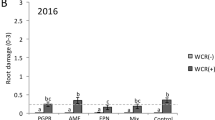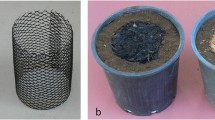Abstract
The root-lesion nematode Pratylenchus thornei is a major pest in the northern grain-growing region of Australia, costing the wheat industry alone $38 million/year in lost production. Biological suppression is being examined as a potential method of reducing populations of P. thornei, which is complementary to the current research focus of breeding tolerant and resistant varieties and using resistant hosts in crop sequences to manage the pest. This study aimed to examine the effect of key farm practices of soil suppressiveness to P. thornei. A field trial was established to determine whether suppressiveness is enhanced by organic amendments (a single application of 0, 5, 10 and 20 t organic matter/ha incorporated into the top soil) and various cropping regimes (bare fallow with residue removed, sorghum with residue retained, sorghum with residue removed). We found that the treatments did not improve soil organic carbon levels but the results of soil nematode analyses indicated that the soil’s biological status changed when these treatments were applied. In the first year after rotation with sorghum, the suppressiveness of the soil increased compared to the fallow treatment. However, in the next year after re-applying the crop management treatments following several months of fallow, soil suppressiveness had declined and difference between treatments were not significant. With the following wheat planting, the soils showed higher suppressiveness in the sorghum residue-retained treatment but that treatment did not affect the yield of two susceptible wheat varieties. The trial also showed that intensive cropping is more likely to induce suppressiveness to root-lesion nematode than a single application of up to 20 t/ha of organic matter.


Similar content being viewed by others
References
Akhtar M (1998) Biological control of plant-parasitic nematodes by neem products in agricultural soils. Appl Soil Ecol 7:219–223
Andersen PC, Brodbeck BV, Bliss CM, McSorley R (2016) Influence of crop rotation and years in bahiagrass on plant-parasitic nematode density in an organic vegetable production system. Nematropica 46:60–70
Baker KF, Cook RJ (1974) Biological control of plant pathogens. WH Freeman & Co, San Francisco
Bongers T (1990) The maturity index: an ecological measure of environmental disturbance based on nematode species composition. Oecologia 83:14–19
Dalal RC, Strong WM, Weston EJ, Cooper JE, Lehane KJ, King AJ, Chicken CJ (1995) Sustaining productivity of a vertisol at Warra, Queensland, with fertilisers, no-tillage, or legumes. 1. Organic matter status. Aust J Exp Agric 35:903–913
Duncan LW, Graham JH, Zellers J, Bright D, Dunn DC, El-Borai FE, Porazinska DL (2007) Food web responses to augmenting the entomopathogenic nematodes in bare and animal manure-mulched soil. J Nematol 39:176–189
Dunn OJ (1961) Multiple comparisons among means. J Am Stat Assoc 56:52–64
Ferris H, Bongers T, de Goede RGM (2001) A framework for soil foodweb diagnostics: extension of the nematode faunal analysis concept. Appl Soil Ecol 18:13–29
Franzluebbers AJ (2015) Farming strategies to fuel bioenergy demands and facilitate essential soil services. Geoderma 259/260:251–258
Goodey JB (1963) Soil and freshwater nematodes. Methuen, London
Hornby D (1983) Suppressive soils. Annu Rev Phytopathol 21:65–85
Hunt DJ (1993) Aphelenchida, Longidoridae and Trichodoridae: their systematics and bionomics. CABI Publishing, Wallingford
Jairajpuri MS, Ahmad W (1992) Dorylaimida. Free-living, predaceous, and plant-parasitic nematodes. Oxford & IBH Publishing, New Delhi
Kumar L, Singh B, Singh U (2015) Effect of sorghum allelochemicals on the mortality and egg hatching of root-knot nematode, Meloidogyne javanica. Int J Bioresour Stress Manag 6:182–191
Li Y, Stirling GR (2010) Biological factors influence nematode distribution in vertosols from the northern grain-growing region. Proceedings, Sixth Australasian Soilborne Diseases Symposium, p 64
Magdoff F, Weil RR (2004) Soil organic matter in sustainable agriculture. CRC Press, Boca Raton
McLeod RW, Steele CC (1999) Effects of brassica leaf green manures and crops on activity and reproduction of Meloidogyne javanica. Nematology 1:613–624
McSorley R (2011) Overview of organic amendments for management of plant-parasitic nematodes, with case studies from Florida. J Nematol 43:69–81
Oka Y (2010) Mechanisms of nematode suppression by organic soil amendments-a review. Appl Soil Ecol 44:101–115
Okada H, Kadota I (2003) Host status of 10 fungal isolates for two nematode species, Filenchus misellus and Aphelenchus avenae. Soil Biol Biochem 35:1601–1607
Paustian K, Andren O, Janzen HH, Lal R, Simth P, Tian G, Tiessen H, Van Noordwijk M, Woomer PL (1997) Agricultural soils as a sink to mitigate CO2 emissions. Soil Use Manag 13:230–244
Ritz K, Black HIJ, Campbell CD, Harris J, Wood CM (2009) Selecting biological indicators for monitoring soils: a framework for balancing scientific and technical opinion to assist policy development. Ecol Indic 9:1212–1221
Sánchez-Moreno S, Ferris H (2007) Suppressive service of the soil food web: effects of environmental management. Agric Ecosyst Environ 119:75–87
Shannon CE, Weaver W (1949) The mathematical theory of communication. University of Illinois Press, Urbana
Siddiqi MR (1986) Tylenchida parasites of plants and insects. Commonwealth Agricultural Bureau, Slough
Smiley RW (2010) Root-lesion nematodes: biology and management in Pacific Northwest wheat cropping systems. Pacific Northwest Extension Publication. PNW617
Stirling GR (2011) Suppressive biological factors influence populations of root lesion nematode (Pratylenchus thornei) on wheat in vertosols from the northern grain-growing region of Australia. Australas Plant Pathol 40:416–429
Stirling GR (2013) Integration of organic amendments, crop rotation, residue retention and minimum tillage into a subtropical vegetable farming system enhances suppressiveness to root-knot nematode (Meloidogyne incognita). Australas Plant Pathol 43:625–637
Stirling GR (2014) Biological control of plant-parasitic nematodes: soil ecosystem management in sustainable agriculture, 2nd edn. CAB International, Wallingford
Stirling GR, Dullahide SR, Nikulin A (1995) Management of lesion nematodes (Pratylenchus jordanensis) on replanted apple trees. Aust J Exp Agric 35:247–258
Stirling GR, Wilson EJ, Stirling AM, Pankhurst CE, Moody PW, Bell MJ, Halpin N (2005) Amendments of sugarcane trash induce suppressiveness to plant-parasitic nematodes in sugarcane soils. Australas Plant Pathol 34:203–211
Stirling GR, Halpin NV, Bell MJ (2011a) A surface mulch of crop residues enhances suppressiveness to plant-parasitic nematodes in sugarcane soils. Nematropica 41:109–121
Stirling GR, Rames E, Stirling AM, Hamill S (2011b) Factors associated with the suppressiveness of sugarcane soils to plant-parasitic nematodes. J Nematol 43:135–148
Stoffelen R, Jimenez ML, Dierckxscns C, Tam VTT, Swennen R, De Waele D (1999) Effect of time and inoculum density on the reproductive fitness of Pratylenchus coffeae and Radophalus similis populations on carrot disks. Nematology 1:243–250
Stone AG, Scheuerell SJ, Darby HM (2004) Suppression of soilborne diseases in field agricultural systems: organic matter management, cover cropping and other cultural practices. In: Magdoff F, Weil RR (eds) Soil organic matter in sustainable agriculture. CRC Press, Boca Raton, pp 131–177
Thompson JP, Owen KJ, Stirling GR, Bell MJ (2008) Root lesion nematodes (Pratylenchus thornei and P. neglectus): a review of recent progress in managing a significant pest of grain crops in northern Australia. Australas Plant Pathol 37:2325–2242
Vanstone VA, Hollaway GJ, Stirling GR (2008) Managing nematode pests in the southern and western regions of the Australian cereal industry: continuing progress in a challenging environment. Australas Plant Pathol 37:220–234
Whitehead AG, Hemming JR (1965) A comparison of some quantitative methods of extracting small vermiform nematodes from soil. Ann Appl Biol 55:25–38
Wilson MJ, Kakouli-Duarte T (2009) Nematode as environmental indicators. CAB International, Wallingford
Yeates GW (2003) Nematodes as soil indicators: functional and biodiversity aspects. Biol Fertil Soils 37:199–210
Yeates GW, Bongers T, de Goede RGM, Freckman DW, Georgieva SS (1993) Feeding habitats in soil nematode families and genera - an outline for soil ecologists. J Nematol 25:315–331
Yeates GW, Wardle DA, Watson RN (1999) Responses of soil nematode populations, community structure, diversity and temporal variability to agricultural intensification over a seven-year period. Soil Biol Biochem 31:1721–1733
Zhao G, Bryan BA, King D, Luo Z, Wang E, Song X, Yu Q (2013) Impact of agricultural management practices on soil organic carbon: simulation of Australian wheat systems. Glob Chang Biol 19:1585–1597
Acknowledgements
This work was funded by the Grains Research and Development Corporation and the Department of Agriculture and Fisheries, Queensland. We appreciate the technical input of Mr. James McLean and Mr. Greg Harvey and crop management support of Mr. Don Browne.
Author information
Authors and Affiliations
Corresponding author
Rights and permissions
About this article
Cite this article
Li, Y., Stirling, G.R. & Seymour, N.P. The effect of organic amendment input and crop management practices on the nematode community and suppression of root-lesion nematode (Pratylenchus thornei) in a grain-growing soil. Australasian Plant Pathol. 46, 463–472 (2017). https://doi.org/10.1007/s13313-017-0508-x
Received:
Accepted:
Published:
Issue Date:
DOI: https://doi.org/10.1007/s13313-017-0508-x




